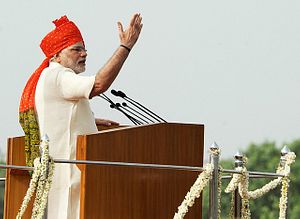Indian Prime Minister Narendra Modi will meet U.S. President Donald J. Trump during a two-day state visit to Washington, D.C., from June 25 to 26. The visit will mark the first meeting between the two leaders and thus the highest level of U.S.-India engagement since the Obama administration left office.
According to a statement released by the Indian Ministry of External Affairs, Modi “will hold official talks with President Trump on June 26.” The talks “will provide a new direction for deeper bilateral engagement on issues of mutual interest and consolidation of multi-dimensional strategic partnership between India and the [United States],” according to the Indian statement.
According to a statement from White House Press Secretary Sean Spicer, Trump will discuss “ways to strengthen ties between the United States and India and to advance our common priorities.”
Among these priorities, the White House statement lists “fighting terrorism, promoting economic growth and reforms, and expanding security cooperation in the Indo-Pacific region.”
“President Trump and Prime Minister Modi will look to outline a common vision for the United States-India partnership that is worthy of their 1.6 billion citizens,” the statement added.
Modi, unlike Chinese President Xi Jinping or Japanese Prime Minister Shinzo Abe, will likely not be invited to join Trump at the Mar-a-Lago club during his visit.
The Indian prime minister will likely look to establish a strong personal rapport with Trump while also intending to preserve high-level continuity in the India-U.S. relationship during his visit.
One area for potential friction is trade, particularly given the Trump administration’s focus on reining in U.S. trade deficits at all costs. The United States ran a $24.3 billion trade deficit with India in 2016.
Beyond the trade balance, the Trump administration has also ordered a review of a skilled visa program that overwhelmingly benefits Indian outsourcing firms. Possible reform to the program, known as the H-1B, could adversely affect Indian interests.
Modi’s meeting with Trump will also come weeks after U.S. Secretary of Defense James Mattis strongly endorsed India’s status as a “major defense partner” for the United States in his speech at the Shangri-La Dialogue.
“Major defense partner” is a bespoke status granted to New Delhi that allows for India to access U.S. defense technology at the same level as key allies and partners. India is seeking access to advanced U.S. defense technology; the two sides made considerable progress in this area in the final years of the Obama administration.
Mattis also strongly endorsed an active role for India as a provider of security in the Indian Ocean region, describing New Delhi as “indispensable.”
Trump has said little about India’s role as a U.S. strategic partner since taking on the presidency, but recently cited India, along with China, as an unfair beneficiary of the Paris climate agreement, signed in December 2015.
When the two leaders meet later this month, they will likely look to emphasize common areas for cooperation and avoid potential pressure points.

































